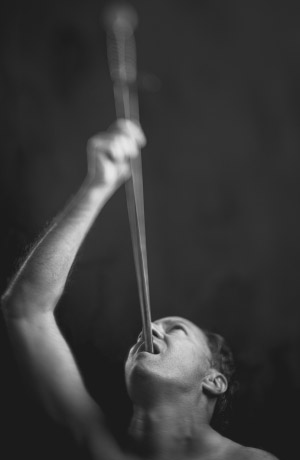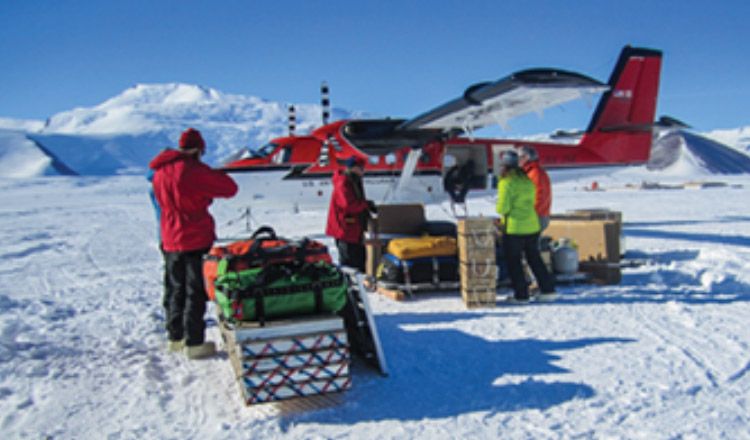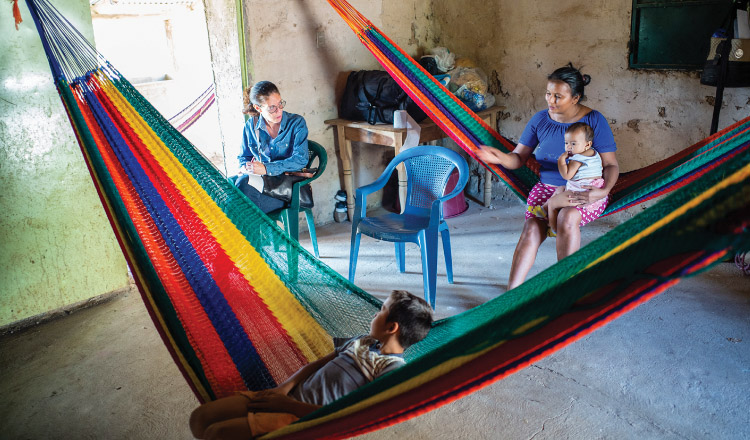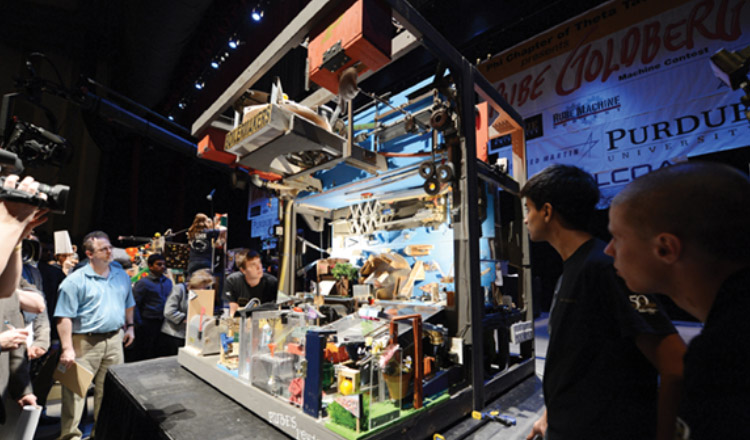What is it like to experience a moment in someone else’s life? We stepped into the shoes of Purdue alumni who have been in history-making, life-changing, or just plain weird moments.
What does it feel like to eat fire and swallow swords?
Joel Van Auken (S’18) and Troy Deckard (MS -S’04) met in the Purdue juggling club and now perform together. Their skills include juggling, swallowing swords, and eating fire.

Troy Deckard: I got up this morning and swallowed two swords right off the bat to start my day. It’s grueling, but you’ve got to do that to stay in tune with them. I use a replica of a World War II German sword. It’s 22 inches long, plus another six or so inches for the grip.
It’s a lot of mind over matter. I stand up straight and stiff, then tip my head back so that my throat, esophagus, and stomach are all in line. The sword goes past my tongue and to the back of my throat. Initially, there is a lot of resistance there. Then, it goes right on down. I can breathe the whole time.
There comes a point where I have to actually nudge my heart out of the way — yes, I can feel that! — and then another really sensitive spot where you will retch if you hit that spot. So I negotiate that. Then it’s down to the stomach. I seat it down there, make a dramatic pose, and pull the sword out. That has to be done just as carefully!
I had my sword rounded, but everything is real. It really goes all the way down to my tummy. It’s dangerous. But I get a lot of satisfaction when I do it well and when the audience receives it well.
Joel Van Auken: You’ve got to be a little bit of a showman to eat fire. I make the torches myself — I wrap the wicking, which is cotton, around the torch and use Coleman camp fuel. It’s fuel with a relatively low flashpoint, which means that it catches fire at a low temperature and evaporates quickly.
I’ll stand with the torch above me, and put the ball of fire right up to my face, and I do feel a bit of heat. It’s bright, intimidating. When I put it in my mouth, I can feel the heat of the torch, and taste and smell the gas. That gas immediately coats the entire inside of your mouth and dries up your saliva. I can hold it there for four or five seconds, and then close my mouth, which extinguishes the flames.
Yes, it’s real, and yes, it’s dangerous. When I learned to eat fire, I learned to exhale slowly. If you breathe in, the vapor evaporating off the torch head will go down into your lungs, and the fire will travel down with it, igniting the fuel inside your lungs. Rules one, two, and three of fire eating are don’t inhale.
What does it feel like to save a life?
Dana Lopes (NRS’04) is a trauma nurse practitioner at a Level I Trauma Center in New Brunswick, New Jersey.
A patient in his late 30s came into the trauma bay who had been in a motor vehicle collision. He had a spleen laceration, but on the initial CT scan, we didn’t see active bleeding, and his vitals were stable, so we sent him to the floor.
I hang out on the floor, especially on weekends where there’s a skeleton crew. The nurse and I noticed that the patient’s heart rate was creeping up. All of a sudden, he started getting diaphoretic — very sweaty. He was getting panicky. It was hard for him to breathe or find comfort.
He had a high heart rate, so I knew it was likely his spleen laceration was starting to bleed, and he was compensating for blood loss in his belly. Further tests indicated that this was true, so I gave him blood. He went to the operating room for an emergent splenectomy, and he was able to fully recover.
The nurse and I caught him before he went into complete hemorrhagic shock. When that happens, you’re not able to circulate blood to the rest of your organs, and they start shutting down. That could have happened if we didn’t intervene so early.
Reacting quickly and knowing that you did the right thing makes you feel good! Not every day in trauma is exciting like Grey’s Anatomy, but some days you get to save a life.

What does it feel like to win Olympic gold?
Amanda Elmore (S’13) had never rowed before she joined Purdue Crew. She rowed in the gold-medal-winning US women’s eight in the 2016 Rio de Janeiro summer Olympic Games.
When we got our boat in the starting block, I was the most nervous I’ve ever been. I was shaking and felt numb, and I had thoughts like, “I just want to go home.” At the same time, I felt prepared and focused.
The race is 2,000 meters long and takes about six minutes. About a quarter of the way through, I glanced over and saw that we were a little behind Canada and the Netherlands, and then our coxswain, Katelin, screamed, “We are the United States women’s eight!” It was incredibly motivating, because at that point the team hadn’t lost a major race in 10 years.
We sprinted for the last 500 meters. My vision started to blur. My legs were burning from the lactic acid. By 250 meters, we had pulled ahead far enough that we could see the back of the second-place boat. When we crossed the line, I felt so relieved and tired enough to pass out. I actually threw up on the way to the medals dock. But then they put our medals on us — they each weigh a little over a pound — and played the national anthem. That was a surreal moment: it’s the first time it’s quiet after the race, so I was able to stand there and realize it actually happened and salute my country.

What does it feel like to perform in front of a huge crowd?
Mass Giorgini (HHS’94, MA’07, PhD LA’14) is the founder and bassist of the punk rock band Squirtgun.
We were performing at a festival in the Czech Republic called Mighty Sounds in 2009, and there were 8,000 people there to see us for that set. I should have been nervous! But we had gotten lost in the rain on a back road in the pitch black on the way there, our van stuck up to its axles in mud. I slipped down a ravine going to get help, and I was covered in mud. I probably looked like a monster from a 1960s horror flick.
We ended up making it to the festival, but we were really tight for our set time. I was sopping wet, muddy, and they hosed me down backstage. When we got on stage, we had huge screens behind us. I looked back and saw myself on screen like a giant — King Kong size. I had gone from thinking I was going to be dead in a ditch to — “Here you are, a rock star.” It was a beautiful stage setup, and the crowd was extremely receptive.
I had fewer nerves playing for such a big audience, because my brain was a little more removed. We had had a misadventure worthy of Don Quixote — but we had a good time. I squished every time I walked.

What does it feel like to go viral?
Senior Tario Fuller will graduate with a degree in law and society. He is a Purdue running back who gained social media fame in 2015 after spontaneously buying a doll as a gift for a little girl at Target.
I went to Target to get something for my birthday. I was into Legos, which explains why I was in the toy aisle. I’ve always been someone who gives back. But every time that I’ve done it, I did it and then moved on.
That night I was sleeping, and then I got up to use the bathroom. I saw I had a Facebook message that shared the story and the photo, and it was like, “Is this you?” I opened it, and I started reading it, and I’m like, “Wait, what?” It had maybe a couple hundred likes or whatever and only a few shares, so like I didn’t really pay any attention.
By the morning, it had thousands of shares. I started getting the notifications, the likes. And then the next thing I know, it went from thousands to tens of thousands.
The first thing that went through my mind was, “It’s just a doll! I don’t know why it’s blowing up.” People from all over the world really, people from Africa, people from London, Australia shared it. It was on newscasts. Good Morning America reached out to me. I think The Ellen DeGeneres Show wanted to do something about it.
My teammates teased me. I had one who was like, “You staged this, didn’t you?” But he was joking. I had negative experiences, too — people thought I was doing it for attention. I didn’t like the way some media agencies would handle it — they’d write a clickbait headline, like “Mother Finds Her 2-Year-Old Daughter with Teen Boy in Toy Store.”
I’m a little indifferent about it. But I feel like it’s important for people to see that there are still good people in the world, and stuff like that does happen.
I had so many friend requests. Now that I have my daughter, I wouldn’t say I’m regretting it, but I don’t know who’s on my Facebook. Most of them are saying they love good people. I gained a lot of fans from that experience, even though I hadn’t played a snap yet.

What does it feel like to do field work in Antarctica?
Christine Kassab (MS S’12) is a doctoral candidate in Earth sciences at Indiana University–Purdue University Indianapolis. As part of her research, she spent eight weeks in Antarctica studying rock moved by glaciers to understand how the ice sheet has changed over time. The information she collected will help scientists make projections for the ice sheet’s future as the Earth’s temperature rises.
McMurdo, the main US base on Antarctica, is like a little city. There are three bars, a church, a doctor, a dentist, a fire station, and close to 1,000 contracted staff to support the 200 scientists. My team had five scientists and a mountaineer. We started in McMurdo and then put our things on snowmobiles and went to the side of the glacier. There, we camped for five weeks.
It was summer in Antarctica when we were there, so it was cold but not prohibitively so — in the 20s at McMurdo and maybe 10 degrees colder where we did fieldwork. I would usually wear two pairs of long underwear with my snow pants and two pairs of socks with my boots and a couple of jackets and hats and gloves. We were all issued a really heavy red jacket we called Big Red, but I didn’t like wearing it because it’s bulky, and I’m five foot two, and it was hard to move around in. We all wore lots of layers and would take them off as needed during the day.
We slept in individual tents. Mine was about 40 degrees at night, so I slept in shorts and a T-shirt and a heavy sleeping bag. “Night” is relative because we had 24 hours of sunlight. I got used to it — I could kind of tell what time of day it was based on where the sun was circling over our heads — and it allowed us to have really long field days. There were times when we would work all day and not get back to camp until 10:00 p.m. to make dinner. Fortunately, I didn’t have any problems sleeping. I just buried my face in my sleeping bag.
I enjoy the simplicity of doing remote fieldwork. I was usually the first one to get up and get water flowing for everybody, so I had a little quiet time to myself. Then everyone would get ready and go out in the field; we’d do work all day, come back and cook dinner, hang out or read, and go to bed. We had generators and solar panels, so we could work on our computers, but we didn’t have internet. I appreciated the simple days and the chance to disconnect, and I would love to go back.

What does it feel like to win a Pulitzer Prize?
Ginger Thompson (LA’86), a senior reporter for ProPublica, was part of the New York Times team that won a 2001 Pulitzer Prize for National Reporting for the series “How Race Is Lived in America.” She was a finalist this year in the Public Service category for reporting about migrant family separation at the US-Mexico border. Those stories included an audio recording of distressed children who had been taken from their parents.
It’s supposed to be a secret when you’re a finalist for the Pulitzer, but many people find out anyway because this is a small business, and reporters like telling secrets. So we knew we were finalists, which was already a huge honor. I had recently become the Times bureau chief in Mexico City, and the Friday before the Pulitzers officially were announced, I got a call from Gerald Boyd, the late deputy managing editor of the Times. He said, “You won, kid.” I said, “You’re kidding.” He said, “No, you should get up here for the announcement on Monday.” I immediately called my mother, and I got on a plane to New York the next day.
On Monday, when the Pulitzer board announced its prizes, we all gathered in the newsroom and waited for them to come across the wire. There’s a flash on the computer screen, almost like when you get a text message on your phone, that says “Pulitzer, National Reporting,” and then “Winner,” and then “New York Times.” The newsroom erupted in lovely, rapturous applause, and the editor made remarks about how important that project was to the country and to the Times, and we had a big champagne toast. It was a thrilling moment, and already knowing we’d won didn’t take away from the real pride and joy and sense of accomplishment of that moment. It’s an amazing thing to be recognized as the best in a category in this country with the most prestigious award you can win as a journalist.
Read the complete series, including Thompson’s story.

What does it feel like to set a world record?
Since he was 3 years old, Zach Umperovitch (S’11) has been building Rube Goldberg machines: chain reactions that make a simple task complicated but entertaining. At Purdue, he led the teams that twice set Guinness World Records for the largest Rube Goldberg machine.
Each year, the Rube Goldberg Machine Contest has a specific task teams have to accomplish. In 2012, it was to inflate and pop a balloon. But that year, we decided to incorporate every task from the past 25 years in chronological order. That included putting a stamp on a letter, making a cup of coffee, and building a hamburger. It ended up being 300 steps, which we realized could break the record we’d set in 2011 with our 244-step machine.
About 75 percent of the way through its run, our machine had to juice an orange. The juice then completed an electrical circuit that triggered the step of making a hamburger. But the oranges would jam the gears if we didn’t squeeze them to soften them exactly the right way. We knew that if we got past that step, the machine would probably work all the way to the end. We had named our machine Lauren, because some of the scrap wood we used randomly had the word “Lauren” written on it, so when we got to the hamburger, we started screaming like crazy: “Come on, Lauren!” Then the steam locomotive engine started chugging, which helped blow up the balloon, and we knew we had it. We had a steam locomotive whistle go off at the end — just a fun “Boiler Up” thing — and everyone cheered.
There are more than 40,000 records in the Guinness database, but only about 4,000 make it into the book each year. Our 2012 machine made it into the 2013 book — it’s just a tiny picture, and we were so proud and happy about it. This year, I opened the 2019 book, and there is a whole two-page spread on our machine at the Rube Goldberg contest. You can’t beat that.

